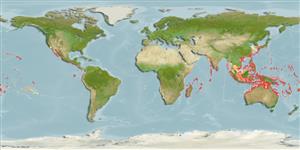Environment: milieu / climate zone / depth range / distribution range
Ecology
Marine; brackish; reef-associated; depth range 8 - 50 m (Ref. 9806). Subtropical; 35°N - 28°S
Southeast Atlantic: off Swakopmund, Namibia (Ref. 11228). Indo-Pacific and Eastern Pacific: South Africa east through Indonesia to the Easter Island and Peru, north to southern Japan, Hawaii, and southern California, south to New Caledonia, New South Wales and Kermadec Islands (Ref. 8879).
Size / Weight / Age
Maturity: Lm ? range ? - ? cm
Max length : 34.0 cm TL male/unsexed; (Ref. 583)
Inhabit coral and rocky reefs of coastal areas (Ref. 9806, 48637). Also common on offshore sand and mudflats (Ref. 48637). Young fish occur in oceanic waters, at or near the surface (Ref. 2850); semi-transparent young may enter estuaries (Ref. 3141). Benthopelagic (Ref. 58302). Feed on benthic invertebrates (Ref. 9806). A large number of juveniles were found in the stomachs of flatheads (Ref. 48637).
Life cycle and mating behavior
Maturity | Reproduction | Spawning | Eggs | Fecundity | Larvae
Matsuura, K., 2001. Ostraciidae. Boxfishes. p. 3948-3951. In K.E. Carpenter and V. Niem (eds.) FAO species identification guide for fishery purposes. The living marine resources of the Western Central Pacific. Vol. 6. Bony fishes part 4 (Labridae to Latimeriidae), estuarine crocodiles. FAO, Rome. (Ref. 9806)
IUCN Red List Status (Ref. 130435: Version 2024-1)
Threat to humans
Venomous
Human uses
Fisheries: of no interest; aquarium: commercial
Tools
Special reports
Download XML
Internet sources
Estimates based on models
Preferred temperature (Ref.
123201): 22.3 - 29, mean 27.7 °C (based on 844 cells).
Phylogenetic diversity index (Ref.
82804): PD
50 = 0.5625 [Uniqueness, from 0.5 = low to 2.0 = high].
Bayesian length-weight: a=0.03548 (0.01723 - 0.07305), b=2.81 (2.62 - 3.00), in cm total length, based on LWR estimates for this (Sub)family-body shape (Ref.
93245).
Trophic level (Ref.
69278): 3.3 ±0.0 se; based on diet studies.
Resilience (Ref.
120179): High, minimum population doubling time less than 15 months (Fec assumed to be > 10,000).
Fishing Vulnerability (Ref.
59153): Low vulnerability (24 of 100).
Nutrients (Ref.
124155): Calcium = 26.6 [10.0, 92.1] mg/100g; Iron = 0.618 [0.303, 1.438] mg/100g; Protein = 19.2 [17.0, 21.4] %; Omega3 = 0.184 [0.091, 0.354] g/100g; Selenium = 16.9 [7.0, 38.1] μg/100g; VitaminA = 27.5 [6.9, 127.0] μg/100g; Zinc = 0.88 [0.55, 1.41] mg/100g (wet weight);
